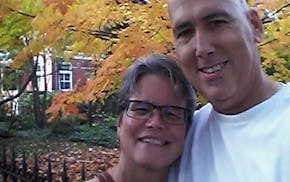I went to a restaurant the other day and something remarkable happened: They told me what I was eating.
Not only that, they put all the nutritional information on the menu, right below the food item, along with the price. The place is called Mill Valley Kitchen, on France and Excelsior, and as far as I can figure, it is perhaps the first stand-alone restaurant in at least the Twin Cities to fess up about its food.
Incredible. Here I've been going to restaurants for many years, joyfully pigging out on whatever landed on my plate, completely unaware if that nice piece of halibut had been sautéed in 19 pats of butter or not. Oblivious to whether that portion of pasta earned me 150 calories or 650. Unsure if I was swallowing one carbohydrate or 1,000.
I could have guessed at those numbers or found a rough estimate for each meal from those online calorie counters, but I didn't take the time, and, besides, those estimates are unreliable.
Guess what happened? Like a lot of Americans, I got fat. Slowly, over many years, I grew. And grew. And grew. I continued to eat at restaurants, and continued to guess how much fat, carbs and calories I was eating. Eventually, I was diagnosed with diabetes.
I wasn't alone. Amazingly, more than one-third of American adults are overweight or obese, costing billions of dollars in health care.
Over the past 10 months, I've changed my diet, lost weight and stayed on an exercise plan, so I've become a bit of an irritating scold on the issue.
In the past two years, Minneapolis and St. Paul have tried to make nutrition information mandatory for some restaurants but failed. A federal law made nutrition counts mandatory for chain restaurants. Even though I know how important tracking what you eat is, I'm not sure I'm for the mandatory menu information for all restaurants. There's mixed research on whether such labeling works.
"Providing the information is helpful to people who care about it and understand what the numbers mean," said Jennifer Nelson, director of clinical nutrition at the Mayo Clinic in Rochester. "But for others it's just a number and it becomes an irritant."
But, said Nelson, "I applaud any restaurant that volunteers the nutritional information because it takes time and costs money."
The guy who gets my praise for going where few tread is Mill Valley owner Craig Bentdahl, a former banker who knows the risk of the restaurant business yet chose to jump into the market and reveal information not everyone wants to hear.
"I've always been interested in health and fitness, and I found it frustrating when I ate out and didn't know what I was consuming," Bentdahl said. He used Canyon Ranch spa and resort in Arizona as a model for the cuisine.
"I used to run long distance, but I also ate a lot of pasta," said Bentdahl. "It wasn't until I changed my diet that I began to see results in my health. We've gotten quite a few comments so far, and they've all been positive."
Mike Rakun, executive chef of Mill Valley Kitchen, said he took the job as a challenge because anyone can make food tasty by using lots of butter and salt. "I bought a case of butter when we opened and I'm still sitting on it," said Rakun. "That's insane in most restaurants."
Rakun inputs all his ingredients into a software program that calculates everything from calories to fat to amino acids even. To keep it simple, they put the calories, fat, carbohydrates and protein of each item on the menu. "Craig is very passionate about eating well and really felt there was a void in this kind of restaurant in Minnesota."
So do I, which is why I was excited to give Mill Valley a little shout-out. Did I mention my lunch was excellent? I had the grilled plum salad and a piece of salmon and got out of the place for about 500 calories.
Here's hoping Bentdahl turns out to be our own Jamie Oliver, the television chef who is trying to improve school lunches in America, and convinces others to follow his lead.
Restaurant owners: The challenge is yours.
jtevlin@startribune.com • 612-673-1702

Tevlin: 'Against all odds, I survived a career in journalism'

Tevlin: Grateful Frogtown couple fight their way back from fire and illness




